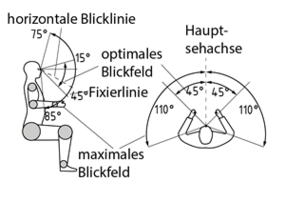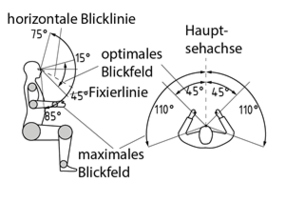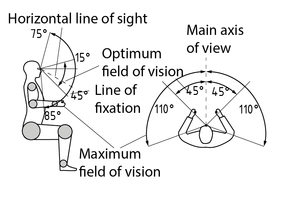
一种定义
四种语言
0,1,2
- 德國
- 英語
- 中國
- 西班牙語
视界

一个人的视界是指他可以直接注视的任何物体区域。在最佳人体工程学视界情况下,一个人能以轻松的姿势(眼睛和颈部肌肉)观察到视界内的所有对象。不应令观察者不断扭动头部来观察。
最佳视界可以观察到主视轴两侧各水平延伸 45°的区域范围,并且能够观察到水平视线上方 15°和下方 45°的区域范围。无需时时查看的对象应置于最大视界区域(主视轴左右侧各延伸 110°的区域范围,水平视线上方 75°和下方 85°的区域范围)。极少观察的对象可以置于扩展视界区域(扭动头部来观察)。
以坐式工作时,固定视线位于水平视线下方 35°。以站式工作时,固定视线位于水平视线下方 30°。为了防止姿势引起疲劳和造成损伤,应该以相同的角度调低视线。
以交替姿势工作时,应当可调节椅子、桌面和屏幕的高度和角度。
视界和视野并不完全相同。
视界的几何图析
Blickfeld

Das Blickfeld ist der Bereich, in dem die Gegenstände liegen, die mit den Augen zentral fixiert werden können. Im ergonomisch optimalen Blickfeld funktioniert die visuelle Wahrnehmung bei entspannter Körperhaltung (Augen- und Nackenmuskulatur). Ständiges Nachführen des Kopfes wird vermieden.
Das optimale Blickfeld liegt horizontal jeweils 45° auf beiden Seiten der Hauptsehachse und vertikal 15° über und 45° unter der horizontalen Blicklinie. Im maximalen Blickfeld (je 110° links und rechts der Hauptsehachse und 75° oberhalb und 85° unterhalb der Sehachse) sollten Objekte platziert werden, die nicht ständig fixiert werden müssen. Gegenstände, die nur selten fixiert werden müssen, können im erweiterten Blickfeld (auch Umblickfeld genannt: der Kopf muss bewegt werden) positioniert werden.
Bei sitzender Arbeitshaltung liegt 35° unterhalb der horizontalen Blicklinie die Fixierlinie. Bei stehender Haltung befindet sie sich bei 30°. Um ermüdende und schädliche Körperhaltungen zu vermeiden, sollte die Blicklinie im gleichen Winkel abgesenkt werden.
Bei wechselnden Arbeitspositionen sollten Stühle, Tische und Bildschirme sowohl höhen- als auch neigungsverstellbar sein.
Das Blickfeld wird vom Gesichtsfeld unterschieden.
Field of vision

A person's field of vision is the area within which they can fix their eyes directly and centrally on any object. In the case of an optimum ergonomic field of vision, a person will be able to observe all the objects in that field while in a relaxed posture (eyes and neck muscles). The observer should not need to continuously move their head.
The optimum field of vision extends 45° horizontally on either side of the main axis of view and 15° vertically above and 45° vertically below the horizontal line of sight. Objects that do not have to be constantly in view should be located in the maximum field of vision (110° to the left and right of the main axis of view and 75° above and 85° below the axis of view). Objects that are looked at only rarely can be located in the extended field of vision (head has to be turned).
In a seated working position, the line of fixation lies 35° below the horizontal line of sight. In a standing position, it is located at 30°. To prevent tiring and harmful postures, the line of sight should be lowered at the same angle.
When working in alternating positions, chairs, tables and screens should be height and angle-adjustable.
A distinction is made between the field of vision and the Visual field.
Campo de visión

El campo de visión de una persona es el área dentro de la cual puede fijar sus ojos directa y centralmente sobre un objeto. En el caso de un campo de visión ergonómico óptimo, una persona podrá observar todos los objetos en dicho campo mientras esté en una postura relajada (músculos de cuello y ojos). El observador no debe necesitar mover continuamente su cabeza.
El campo de visión óptimo se extiende 45° horizontalmente a cada lado del eje de visión principal, y 15° verticalmente por encima y 45° verticalmente por debajo de la línea de visión horizontal. Los objetos que no necesitan estar constantemente a la vista deben ubicarse en el campo de visión máximo (110° a la izquierda y derecha del eje principal de visión, y 75° arriba y 85° abajo del eje de visión). Los objetos que solo se ven raramente pueden ubicarse en el campo de visión extendido (se tiene que girar la cabeza).
En una posición de trabajo sentado, la línea de fijación queda 35° debajo de la línea de visión horizontal. En una posición parado, se ubica a 30°. Para prevenir posturas cansadoras y dañinas, la línea de visión debe bajarse al mismo ángulo.
Cuando se trabaja en posiciones alternantes, las sillas, mesas y pantallas deben ser ajustables en su altura y ángulo.
Se debe distinguir entre el campo de visión y el campo visual.
Geometría del campo de visión
